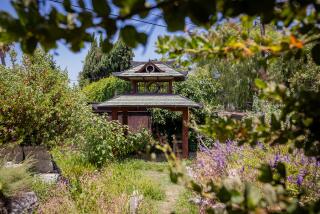It’s Easy to Keep Topiary True to Form
- Share via
Disneyland. “Edward Scissorhands.” You know what we’re getting at: Topiary, that ancient garden art of sculpting bushes into mythical, whimsical or literal depictions of figurines, or geometric or ornamental shapes.
Trimming, shaping, tying and training plants takes time, but don’t panic--topiary isn’t going away. It’s been around since the Roman Empire, when ornamental gardens, called topia were meticulously manicured by garden designers, called topiarius.
Only wealthy and powerful Romans could afford to maintain these gardens. The fall of the Roman Empire brought down the art of topiary, and it wasn’t until the European Renaissance that the garden art regained popularity.
It’s making its way into Southern California gardens and patios, but not fast enough for Patricia Riley Hammer, owner of Samia Rose Topiary in Encinitas, and author of “The New Topiary” (Garden Art Press, 1991).
“People here have a long way to go,” she says. “So many people are afraid of topiary. My mission is to help them get over their fears.”
Since establishing Samia Rose Topiary in 1992, Hammer has created life-size elephant topiaries for the San Diego Zoo; green athletes for the ’96 Olympic Games in Atlanta; and a garden party featuring 75 Victorian-costumed adults, children and pets, strolling to the strains of a topiary orchestra.
Hammer’s rhinoceros, Arabian oryx, wild horses and giant condors will greet visitors to the Del Mar Fair when it opens June 17. The exhibit is part of the San Diego Wild Animal Park’s celebration of its 25th anniversary and features life-size topiary of endangered animals.
For many years, she was the senior gardener and topiary expert at Longwood Gardens, Kennett Square, Pa., famous for its distinctive displays.
Although topiaries are often thought of as living sculptures suitable mainly for large estates, where massive obelisks, cones, or triangles define distinctive garden rooms or pathways, topiary can also be informal and relatively inexpensive.
Hammers says people are reluctant to buy a topiary priced at $50 or $60 because they’re afraid of killing it, yet “they think nothing of spending $45 on a floral bouquet that will only last a week or so.” She says that with a little care, the topiary will flourish for years.
Hammer says many Southern California gardens already have topiary, although not in the true artistic sense.
“Any time a bush is shaped or pruned and the natural growth pattern is altered according to the gardener, that’s a type of topiary,” she says. “But most people just settle for meatballs and caterpillars--round balls or box hedges--we’re not imaginative enough.”
*
There are two distinct types of topiary.
One involves the painstaking trimming and training of living shrubs or trees into geometric forms, whimsical shapes or realistic depictions of humans or animals. They can take years of meticulous work and are expensive to buy.
Another type involves the creation of sculptures made from wire or metal, filled with sphagnum moss and planted with green plants, usually a type of ivy. Ranging in size from inches to many feet, these can be placed in gardens or used on tabletops for instant effect.
Karen Robbins, who with her husband, Clifford, established The Twisted Leaf in Tustin, specializes in the quicker kind of topiary.
An entrepreneur with a graphic design background and a topiary enthusiast, she designs and manufactures metal frames--87 different shapes so far--that are set in terra-cotta pots. Ivy, which is planted in potting mix, is trained to vine and twist along the frame. They cost around $25 to $30.
“This is a really simple type of topiary because it eliminates the need for moss and a lot of the tying you have to do with frame-filled topiaries,” she says.
She spends hours each day tending her 80 topiaries, but people with one or two can ensure good growth with just five minutes of daily care--watering, trimming, training.
Hammer says a mistake she often sees is not grooming the topiary and letting the plant overtake the frame, obscuring the original design.
“Pin and clip regularly,” Hammer says. “Don’t wait until it’s a big, green glob.”
(BEGIN TEXT OF INFOBOX / INFOGRAPHIC)
Tending Topiary
* Keep topiary figures off the ground, especially those filled with moss, since they attract pill bugs and other insects. Place on a pedestal or inverted flowerpot.
* Moss dries out quickly, so establish a regular watering schedule. In hot weather, water daily. Along the coast, or in cooler temperatures, water several times a week.
* Topiary is not only a sculpture, but also a living plant that requires fertilizer. Use a liquid fertilizer according to package directions and apply monthly or more often in the growing season.
* Inspect regularly for new growth. Train new tendrils on form by pinning or twining, depending on type of topiary.
* If the topiary is attacked by spider mites or other insects, combat them with applications of insecticidal soap.






